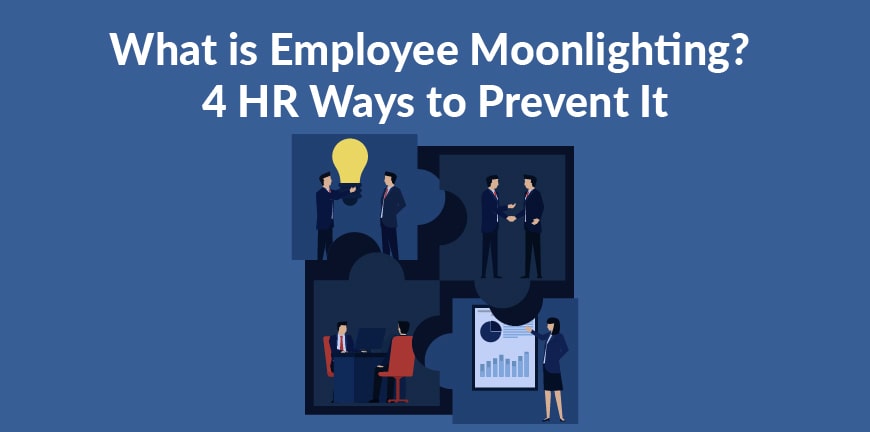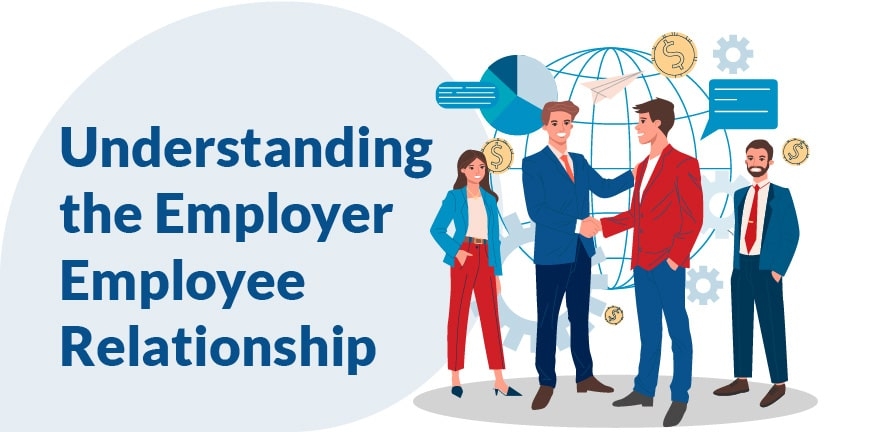
International Human Resource Management
21/12/2023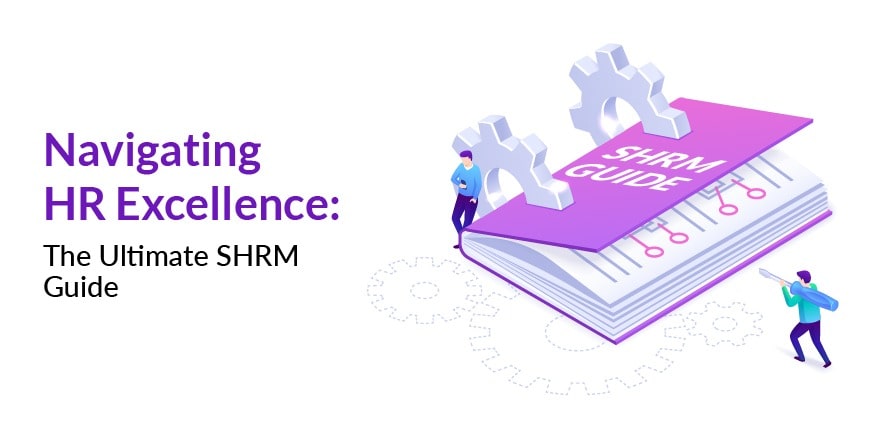
What Is Strategic Human Resource Management? (2024 Guide)
23/12/2023- What is Employee Moonlighting?
- Why has moonlighting become common in Modern Workplaces?
- Is Moonlighting legal in India in 2026?
- What are the Different Types of Employee Moonlighting?
- How does the tech industry play a role in enabling moonlighting?
- What are the drawbacks of employee moonlighting?
- What are the 4 effective measures that HR can take to prevent moonlighting?
- What Should a Company Include in Its Moonlighting Policy?
- What are the examples of employee moonlighting?
- Closing words
- Frequently Asked Questions (FAQs)
Moonlighting is a side hustle that an employee with a full-time or part-time job takes up, mostly without the primary employer knowing about it. These jobs are often performed during off-hours or weekends. One of the most common reasons why employee moonlighting happens is when an employee seeks another job to increase their income.
Moonlighting has become more common than ever these days and is plaguing, especially in the IT, tech, health, and education industries, creating much stir among industry leaders, startup founders, and HR departments of organizations.
The CEO of Wipro, Thierry Delaporte, said he is OK with someone having a side hustle, but with absolutely no conflict of interest, and the chairman of the company, Rishad Premji, openly expressed his dislike for moonlighting. He further justified the sacking of 300 employees, saying they were caught red-handed working with direct competitors.
On the other hand, there are some companies that do allow moonlighting. Deccan chronicles reported that Swiggy allows its employees to pursue side hustles under their pioneering moonlighting policy.
Some of the apparent reasons why business leaders are against moonlighting are security threats to critical data and information, decreased productivity, and other ethical concerns.
What is Employee Moonlighting?
Employee moonlighting happens when an individual takes up a side job, outside the hours of their regular job, to earn extra money, but without the knowledge of their full-time or regular job employer. This other job could be freelancing, consulting, or a part-time job in a different profession altogether. Another important factor that makes it different from having multiple sources of income is that it’s a different kind of employment. Moonlighting employees grew in number during recent years as hybrid and remote work models caught up. This flexibility allowed individuals the time to work in other jobs while managing their primary jobs.
Why has moonlighting become common in Modern Workplaces?
Moonlighting has become persistent in today’s time due to various reasons.
- Extra income- The change in standard of living, higher living costs, lower salaries, and bigger financial goals have led employees to take on additional jobs and supplement their single incomes.
- Pursue passion- Most people, to explore other interests or old passions, or hobbies, take up side businesses. This is not only for personal satisfaction but also helps explore different career opportunities.
- Job insecurity- The job market is so uncertain that employees, out of fear and to make sure they have a job at the end of the day to support themselves, look for a side hustle and cast themselves in a safe place.
- Flexibility and technology- Remote work, flexible schedules, and a ton of freelancing opportunities have led people to use their time to make extra income by taking up other jobs.
- Skill development and growth- Moonlighting allows employees not just to work in other jobs, but also to gain skills and experience without having to leave their primary job.
Is Moonlighting legal in India in 2026?
Moonlighting in India is not exactly illegal because there is no law against it. However, there are certain limitations that individuals must consider-
- Dual employment is not allowed for adult workers in factories. No worker can work in two factories on the same day.
- Companies that do have a problem with moonlighting specifically include it in their employment contracts. This could be so as to avoid conflicts of interest, ensure higher productivity, or avoid data and confidentiality breaches. In such cases, if employee moonlighting happens, then these individuals may face termination or could be taken to court for further legal action.
- Under Article 21 of the Indian Constitution, of right to livelihood, employees are given protection if they want to work in other jobs to earn extra income. However, this too must be cleared with the employer first.
- Income that comes from moonlighting is taxable, and employees must inform and declare it properly.
So, while moonlighting isn’t illegal by itself, whether it’s allowed or not mainly depends on the terms of your job contract.
What are the Different Types of Employee Moonlighting?
Employee moonlighting is of diverse types, depending on the employee’s needs. The 4 main types are-
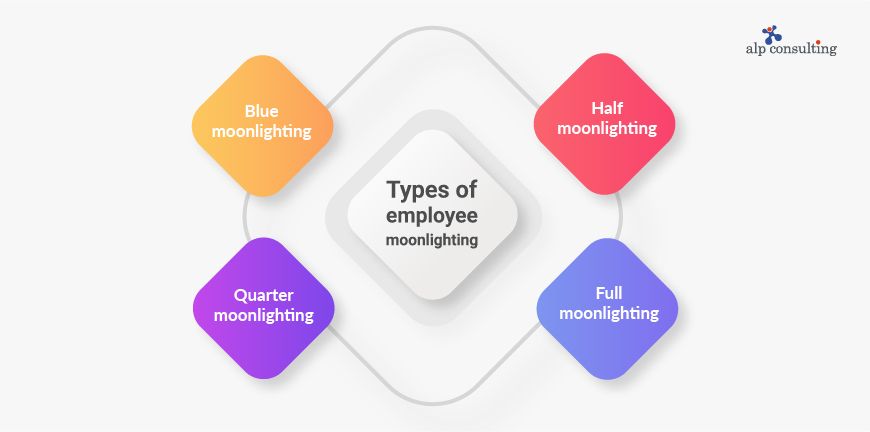
1. Blue moonlighting
Not everyone is equipped enough or can handle a side hustle along with a regular full-time job, regardless of the reasons. They tend to become unproductive in one of the two jobs or even both jobs. This failed attempt at dual employment of an employee is called blue moonlighting.
2. Quarter moonlighting
Quarter moonlighting is when an employee takes up a part-time job that lasts for about 2-4 hours after their regular working hours.
3. Half moonlighting
In half moonlighting, the employee leaves almost no time for himself, as he spends nearly half his free time after his full-time job in a part-time job that requires almost just as much effort as the full-time job to earn extra money.
4. Full moonlighting
This is when an employee successfully manages to handle two jobs simultaneously, a full-time job and a side hustle.
How does the tech industry play a role in enabling moonlighting?
It would not be right to solely blame the employee for moonlighting. We will tell you why. It is like an employee, a regular office-going individual working a 9 to 5 job, to wonder about an alternative path and think of making an extra income to afford a better and more comfortable lifestyle.
And honestly, working after your regular hours on a different job is not illegal, as long as you do not have to misuse the resources of your regular job to get it done, and it is not affecting the quality or productivity in your full-time job. But in reality, only a few come through, which is why organizations are mostly against moonlighting.
Former director of Infosys, Mohandas Pai, had stated that moonlighting is much more common among the entry-level salaried employees compared to those in bigger, prominent roles.
Some of the major enablers of moonlighting were
- The PANDEMIC, when everyone was required to work from home, gave them an increased opportunity to pick up side
- A failed system of monitoring remote working employees, allowing them to wander a new path.
- Surge in gig opportunities is tempting people to make quick bucks.
- A higher level of technology made it easy for moonlighters to work with bigger companies located miles away from them.
What are the drawbacks of employee moonlighting?
Moonlighting causes the overworking of an employee, as they have multiple jobs and responsibilities to handle, resulting in chronic stress, poor work-life balance, not just affecting their health but also your productivity.
Some of the major drawbacks are-
1. Productivity downfall
Working multiple jobs causes physical and mental fatigue, further leading to weak memory, lower engagement, performance, and productivity.
2. Conflict of interest
If employees take up jobs from competitors, it can create a conflict of interest in the workplace. Helping your competitor develop related products or services in plain words is just unethical. You are basically cheating on your current employer, which may have a financial impact on their business. It is a big NO.
3. Compromises confidentiality
If the employee takes up a similar job at another company, there can be an elevated risk of breach of confidentiality pertaining to products, data, or other trade secrets.
4. Abuse of company resources
Using the company’s resources, such as company laptops, software, or other resources, for their side hustles or second jobs is not right. It leads to abuse of resources.
But moonlighting is not illegal, and it mostly depends on individual company policies.
What are the 4 effective measures that HR can take to prevent moonlighting?
Increased job satisfaction and higher employee engagement, better benefits can definitely help manage moonlighting to an extent. Additionally, the involvement of HR in the matter can prove to be far more effective than you anticipated.
Let us take a look at how HR can be instrumental in preventing employees from moonlighting.
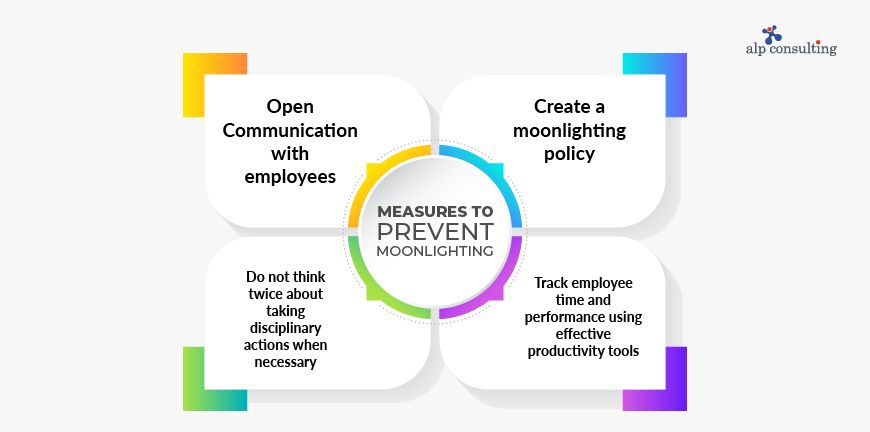
1. Open Communication with employees
HRs are known to be people’s people! Use this to your advantage. Appoint an HR expert and have open communication channels with your employees. Talk to them about why they are feeling the need to resort to moonlighting.
If they want to pursue a passion or need an additional income, as their employer, you can offer them a flexible schedule, allowing them to balance both. But do talk to them about the effects of moonlighting on their business.
2. Create a moonlighting policy
You can have the HR department draft a proper moonlighting policy that can help prevent moonlighting from affecting your business. Before creating a moonlighting policy, make sure you have addressed the following questions-
- Are employees prohibited from working in other industries or unrelated fields after working hours?
- Do employees need to notify their managers before taking on an additional job?
- What will happen if a staff member takes a second job without prior approval?
- How will this affect the employee’s right to the benefits you provide?
You can add one of these to the employment contract or agreement with the aid of the right legal advice, making sure that you are not violating the state employment laws.
1. Non-compete
Employees agree not to work with a competitor for a specific time after the employment period.
2. No performance hindrance
Set out an expected performance from the employee. Ensure that they treat this as their main/primary job and that their side hustles will not interfere with their performance. HR experts draft this after seeking the right legal advice.
3. Do not think twice about taking disciplinary actions when necessary!
No, we are not saying you need to be hard on your employees. But in this case, if moonlighting is affecting the quality of their performance, then you must take the necessary action.
Here are some disciplinary actions you can incorporate-
- Issue warning letters if their graph of productivity has been declining over time.
- Order suspensions if the moonlighting employees are performing poorly.
- Terminate the employees compromising confidential company information.
4. Track employee time and performance using effective productivity tools
After all your efforts of making a policy, talking to them about the consequences, and providing flexibility, if you are still worried about moonlighting employees, you can use an activity tracker, a tool that can be easily installed on computers.
- A versatile software can be linked to the timesheets to determine and validate the work being performed by employees daily.
- Project time tracking software is one of the effective ways of ensuring your employees do not take up additional jobs.
What Should a Company Include in Its Moonlighting Policy?
An effective Moonlighting Policy should include the following components:
1. Definition of Moonlighting
Clearly state what exactly moonlighting is inside the organization or outside employment, if taken regarding the organization’s policies and procedures.
2. Scope and eligibility
State specifically which employees must follow the policy. Also, make sure to state the restrictions for certain crucial roles.
3. Permitted and Prohibited Activities
Mention clearly all the activities and work that are acceptable and those that can cause conflict of interest, like working for direct competitors or using company resources for other jobs.
4. Disclosure or approval process
Employees must mention if they have taken up another job outside the organization and must get approval from their primary employer. Make sure to mention how requests must be submitted, what information the employees must provide, and timelines to approve decisions.
5. Confidentiality and Non-Compete Clauses
Reinforce any existing confidentiality agreements or non-compete clauses that employees must adhere to while engaging in moonlighting activities. Emphasize the importance of protecting company secrets and proprietary information.
6. Use of company resources
Company time, resources, and equipment must not be used for the benefit of outside jobs. This would be considered as moonlighting activities.
7. Impact on Performance
State that moonlighting should not interfere with the employee’s performance, attendance, or availability for their primary job. Highlight the consequences of any negative impact on their work.
8. Disciplinary Actions
Clearly outline the potential consequences for violating the Moonlighting Policy, including disciplinary actions that could range from warnings to termination, depending on the severity of the violation.
What are the examples of employee moonlighting?
Some of the key examples of employee moonlighting are-
Teaching and tutoring- School teachers usually teach in schools during their daytime hours, and to make more income, during after-school hours, they do private tutoring.
Doctors and private practices- Doctors who work in private hospitals have their own practices in clinics during off-hours.
Content creators- Individuals in the marketing field use their free time to create content on trending topics to build their personal profiles.
Freelancing- Graphic designers, content writers, and software developers take up freelancing jobs to gain experience as well as get some extra income.
Closing words
Moonlighting can result in overworked, exhausted, unprofessional, and unproductive employees at the workplace failing to utilize their potential to the best of their abilities. HRs are the first line of individuals in a company capable of having a heart-to-heart conversation with your employees/colleagues about their problems, whether they are moonlighting or not, how moonlighting can affect their regular jobs, and the chances of progressing in their careers if they lose balance.
With the necessary information, it’s easier for HR to help boost job satisfaction, improve employee engagement, and define clear expectations via a moonlighting policy without snubbing the expectations and needs of employees.
Frequently Asked Questions (FAQs)
1. What is employee moonlighting?
Employee moonlighting happens when an individual takes up a side job, outside the hours of their regular job, to earn extra money, but without the knowledge of their full-time or regular job employer.
2. Is moonlighting legal in India in 2026?
Moonlighting isn’t exactly illegal in India. Employees are allowed to take up other jobs; however, if there are clauses by the primary employers and a certain set of employees in some fields, then moonlighting may be considered illegal.
3. Why do employees engage in moonlighting?
Employees engage in moonlighting to earn extra income, gain skills and experience, or explore new career opportunities.
4. What are the risks of moonlighting for employers?
Conflicts of interest, decreased productivity, data breaches, misuse of resources, burnout or exhaustion, legal concerns, etc, can be some risks of moonlighting for employers.
5. How can HR prevent moonlighting in India?
HR can prevent moonlighting by encouraging open communication with employees, creating a moonlighting policy, taking disciplinary actions when necessary, and tracking employee time and performance.
6. Which companies allow moonlighting in India?
Under specific conditions, a few companies allow moonlighting in India. This includes Swiggy, Tech Mahindra, Infosys, etc.
Contact Us For Business Enquiry

Rajkumar Shanmugam
Rajkumar Shanmugam is the Head of HR at ALP Consulting, bringing over 19 years of comprehensive HR leadership experience across India and international markets. His expertise spans talent acquisition, employee relations, performance management, compliance, and HR transformation. Rajkumar has a proven track record of driving people-centric initiatives, enhancing workplace culture, and aligning HR strategy with business goals. With extensive experience in US staffing operations and global mobility, he continues to lead organizational excellence through innovation and employee engagement.

